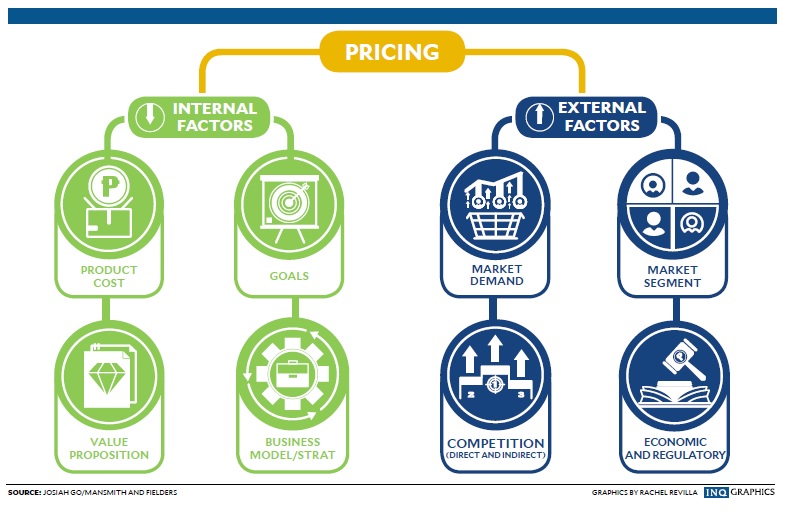Pricing 101: Approaches, new products and factors
The function of price is to make the product affordable or attractive to the target market while also reflecting the value of the benefits provided. In other words, price is an indicator of how the value of products or services is perceived by the buyers based on the pain points solved.
Three concepts need to be understood: value, price and cost.
Pricing for newbies
The difference between price and cost is the margin or profit, while the difference between the value and the price is called surplus.
For example, if the perceived value is P12 and the price at which consumers buy (or at which the company sells) is P10, consumers get a perceived surplus of P2. This is the equivalent of what Filipinos call sulit (worth it). The difference in price of P10 and the cost of P4 gives a margin of P6 per unit. This is the equivalent of what Filipinos call kita (income).
Price is therefore dependent on both the utility as well as the perceived value the product or service creates. A small can of soft drinks can be bought for P50 in a small sari-sari store, maybe for P60 in a 24/7 convenience store, P150 in a luxury restaurant or P200 while hiking to the top of a mountain—all because the same product provides different value to the consumers depending on context such as occasion or availability.
Price is also the twin element of sales volume that makes up sales revenues (or sales revenue = price x sales volume). Pricing a product should therefore be revenue maximizing without forgetting the margin and the bottom line the firm intends to make. The revenue-maximizing price is the price that achieves the highest sales revenues, where the quantity or sales volume outweighs the price effect. As presented in the example here, the revenue maximizing price is P10 based on a hypothetical price sensitivity research; or if an item is priced at P1 or P2 more, less people will buy and therefore deliver less revenues.
Sales revenues = price x sales volume
• Option 1: P10 million = P10 x 1 million units
• Option 2: P8.8 million = P11 x 800,000 units
• Option 3: P6 million = P12 x 500,000 units
3 common pricing approaches
There are three common approaches to establishing a selling price:
Cost-based – price is based on a percentage markup of cost;
Value-based – price is based on perceived value; and
Market-based – price is competitive with what is available in the marketplace.
New product pricing
Since new products need to be tried before consumers can adopt them, firms often launch at introductory prices so consumers can feel a greater surplus, managing customers’ fear of the risk of a new product trial. It then adjusts its prices upward after the intended trial level has been achieved in a few months.
Introductory prices should not be too far from the intended price as it may attract a totally different market segment other than its intended target market. For instance, a 10-percent to 20-percent introductory discount can still attract the intended market segment, but not when the introductory price is discounted by 50 percent or more, as it may unduly attract the bargain hunters instead.
Factors to consider in pricing
There are internal as well as external considerations that marketers must look into when pricing their products. Internal factors to watch to ensure profitability are: 1) product cost 2) goals 3) value proposition and 4) business model and strategy. External factors, on the other hand, ensure that the pricing is attractive to the market segment, to stimulate market demand, while considering competition and substitutes (direct or indirect) as well as the economic and regulatory landscape.
—Contributed
Josiah Go, chair and chief innovation strategist of Mansmith and Fielders Inc., is joining forces with marketing anthropologist Chiqui Escareal-Go and digital marketing consultant RG Gabunada to launch their book “Marketing for Beginners” on Oct. 11, 6 p.m., at the east wing of Shangri-La Mall, Mandaluyong. Open to the public, RSVP at beya.mansmith@gmail.com.

